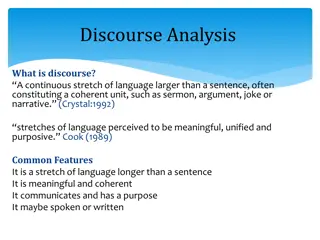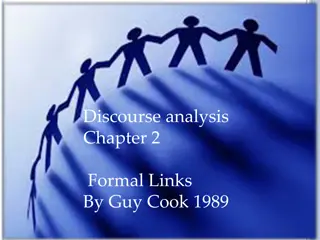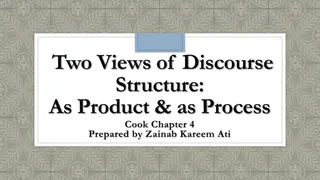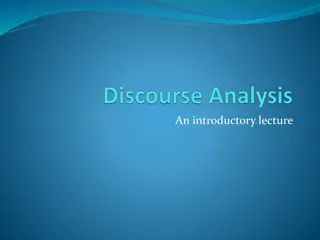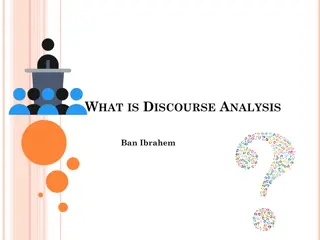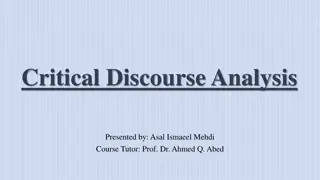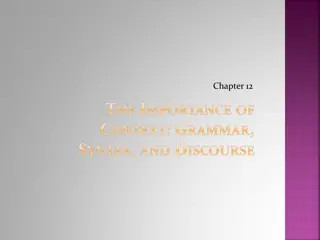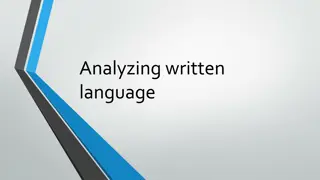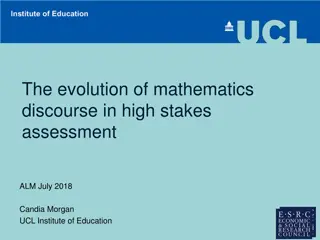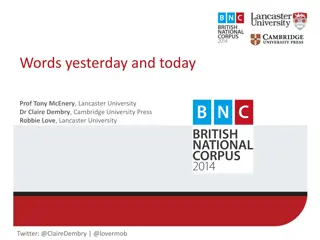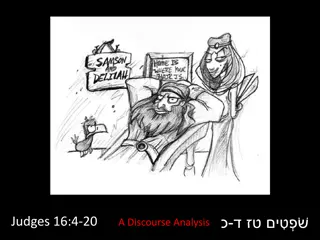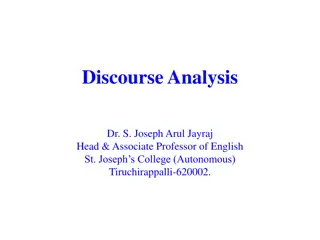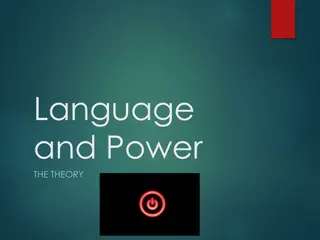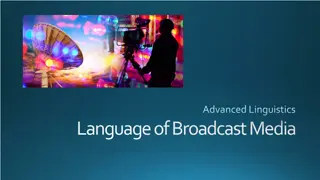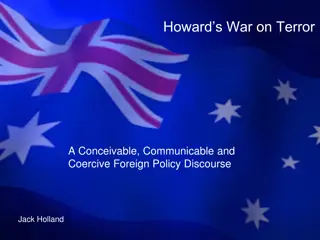Discourse Analysis: Language in Social Contexts
Delve into the realm of discourse analysis focusing on the connection between language usage and social settings from the perspectives of linguistics, psychology, anthropology, and sociology. Explore the works of key figures like Dell Hymes, M.A.K. Halliday, and the contributions of semiotics and French structuralists. Discover how discourse analysis distinguishes between language forms and discourse functions, emphasizing the functional aspect of language in various situations and cultural contexts.
Download Presentation

Please find below an Image/Link to download the presentation.
The content on the website is provided AS IS for your information and personal use only. It may not be sold, licensed, or shared on other websites without obtaining consent from the author.If you encounter any issues during the download, it is possible that the publisher has removed the file from their server.
You are allowed to download the files provided on this website for personal or commercial use, subject to the condition that they are used lawfully. All files are the property of their respective owners.
The content on the website is provided AS IS for your information and personal use only. It may not be sold, licensed, or shared on other websites without obtaining consent from the author.
E N D
Presentation Transcript
Discourse Analisys 1- Language in Use D.A. deals with language in context, linking the text/utterance with its social situation. 1960s and 1970s out of work in different disciplines: linguistics, psychology, antropology, sociology. Contribution of semiotics and the French structuralists approach to the study of narrative. Dell Hymes: speech in social settings (1964); Language as social action: speech-act theory, conversational maxims (Austin, 1962; Searle, 1969, Grice, 1975), pragmatics, i.e. the study of meaning in context (Levinson, 1983; Leech, 1983).
Discourse Analisys 1- Language in Use Every day we encounter or take part in a wide range of different types of spoken interactions . Each situation has its own conventions and formulae, different role relationships, different purposes and different settings. Discourse analysis is interested in all the above creating a fundamental distinction between: LANGUAGE FORMS (grammatical, lexical, phonological) and DISCOURSE FUNCTIONS (what we do with the language)
Discourse Analisys 1- Language in Use D.A. is interested in the relationship between discourse forms (grammatical, lexical, phonological) and discourse functions. Forms are the RAW materials which enable students to use language FUNCTIONALLY. British D.A. was greatly influenced by the work of M.A.K Halliday s functional approach to language (1973). His framework emphasizes the social functions of language and the thematic and informational structure of speech and writing
A text is language that is functional, that is to say . D.A. is interested in the relationship between discourse forms (grammatical, lexical, phonological) and discourse functions. language that is doing some job in some context (Halliday in Halliday & Hasan, 1985/ 1989: 10). In this functional perspective, a text is therefore always seen as being strictly related to: 1- its Context of Situation, which is defined as the immediate Forms are the RAW materials which enable students to use language FUNCTIONALLY. social and situational environment in which a text is being realized, 2- the Context of Culture which is the outer , more external, or higher-order context surrounding both the text and its specific Context of Situation.
https://education.waikato.ac.nz/books/literary/ReadingSit.jpghttps://education.waikato.ac.nz/books/literary/ReadingSit.jpg
A text, therefore, is basically made of meanings that, in order to be communicated, need to be encoded and expressed through a system of graphic, phonic or visual signs. As a thing in itself, it is a consistent semantic unit.
A text is both an object, a product of its environment, of its Context of Situation and Context of Culture, and an instance of social meaning in a specific situation. The relation between text and context is a systematic and dynamic one: - on one hand, a text is the result of the context in which it is being realized and where language is being shaped to function purposefully; - on the other hand, a context is then realized in turn by the text: through a text a context is being created. (Halliday in Halliday & Hasan, 1985/ 1989: 10-11).
Context of Situation Context of Situation is seen as being comprised of 3 components, or values, or dimension of variation: Field, Tenor and Mode, or, respectively: FIELD: what is going on? TENOR: who is taking part? MODE: how are the meanings being exchanged?
Field, Tenor and Mode. Field the nature of the ongoing social speech event and its subject matter, what is being spoken about; Tenor the human participants in the interaction and the relationship between them, involving their status and discourse roles, as well as the attitude they take towards the subject matter and their interlocutors, Mode the way that language is functioning in the interaction, which involves a series of features such as the degree to which the process of interaction is shared by the interlocutors, its channel , its medium etc. (see Halliday & Hasan, 1985/ 1989: 12)
Discourse Analisys Semantic meaning (without the context) serves a pragmatic purpose [pragmatics: what people mean] Utterance (enunciato). Linguists sometimes use utterance to simply refer to a unit of speech under study. The corresponding unit in written language is text. Importance of context and shared knowledge. Overheard during a flight: I think we should keep him somewhere safe where he doesn t hurt anyone ;
Discourse Analisys 1- Language in Use Language as communicative purpose (function) Text: actual use, not an abstract unit of language (its purpose or function, something to act upon) What a terms denotes vs what it refers to
Discourse Analisys Slow Children Crossing P1 s intention P2 s interpretation mediated through mediated through DISCOURSE DISCOURSE P1-------------------------------------- TEXT ------------------------------------P2 speaker encoding writer decoding listener reader I think we should keep him somewhere safe where he doesn t hurt anyone
Discourse Analisys Semiotics (Barthes) Sign = Signifier + Signified SIGNIFIER = physical representation of a thing or of a concept. It is the EXPRESSION. SIGNIFIED = meaning. It is the CONTENT. CONTENT may be: denotative (the brain definition) connotative (the deeper meaning - see, for ex., the word dog ).
Discourse Analisys Semiotics (Barthes) There is no place like home (Dorothy, The Wizard of Oz ). HOME (signifier, physical representation, the expression : morphological, phonetical, lexical) HOME (signified, the content): Denotative content: the brain definition: home as a building, the place where I live; Connotative content: the deeper meaning, the warmth, the atmosphere
Semiotics Barthes Objects have meanings. Such meanings may be: symbolic (= connotative meaning) they have a metaphorical meaning taxonomic (=denotative meaning) they are included in a system where things are named and organized. They are classified.
Barthes and the Rhetoric of Images
Semiotics Barthes Objects, regarded as symbols, have connotative meanings Connotative meaning of objects can be: Existential Related to life but with non-human elements market Aesthetic Related to design for instance, still nature Technological Related to technology i.e., when the object is useful for something else
Discourse Analisys 2- Communication Knowing a language (intuitive) vs knowing about a language (explicit knowledge of encoding conventions). Linguistic competence. But our interpretation of a discourse involves more than our linguistic competence. Examples: He done somefing really evil and now I m gonna kill im. Her as was has gone from we. We as is will go to she. We also consider what is appropriate in a given situation. Norms and forms of a language Task: ways in Italian to express disgust, from most formal to most informal.
Discourse Analisys 2- Communication Proposition (we talk about something) Reference (we make a connection with context) Examples: His flight should be here any minute. I m on my way Speech Act Theory (John Austin 1962, John Searle 1969) Locutionary Act Illocutionary Force Perlocutionary Effect
Discourse Analisys 2- Communication Speech Act Theory (John Austin 1962, John Searle 1969) Locutionary Act Illocutionary Force Perlocutionary Effect Is there any salt? In uttering the locution "Is there any salt?" at the dinner table, one may thereby perform the distinct locutionary act of uttering the interrogatory sentence about the presence of salt, as well as the illocutionary act of requesting salt (illocutionary force of request), perlocutionary effect of causing somebody to hand one the salt. and the further
Discourse Analisys 2- Communication Speech Act Theory (John Austin 1962, John Searle 1969) Direct and Indirect Speech Acts Example (after a dinner with friends): Man: Let s have coffee at our place Wife: You re working tomorrow This is an indirect speech act. The wife could have expressed the same message with a direct speech act: Man: Let s have coffee at our place Wife: I am tired, I want to go to sleep
Discourse Analisys 2- Communication Speech Act Theory (John Austin 1962, John Searle 1969) Direct and Indirect Speech Acts Direct Speech Act: grammatical form and communicative function (i.e. illocutionary force) correspond. Indirect Speech Act: grammatical form and communicative function do not correspond. Is there any salt?? Other examples (requests and proposals): - Would you like to meet for a coffee? - I have class . - Can you call Samantha?
Discourse Analisys 2- Communication Dell Hymes s 4 aspects of communicative competence Hymes' original idea was that speakers of a language have to have more than grammatical competence in order to be able communicate effectively in a language; they also need to know how language is used by members of a speech community to accomplish their purposes. Four kinds of judgement: 1- Whether (and to what degree) something is formally possible 2- Whether (and to what degree) something is feasible 3- Whether (and to what degree) something is appropriate in relation to the context in which it is used 4- Whether (and to what degree) something is actually performed
Discourse Analisys 2- Communication 1- possible 2- feasible 3- appropriate 4- performed 1- Something possible within a formal system is grammatical 2- (ambiguity) Visiting aunt can be boring; I met a man with a glass eye called Eric; two sisters were reunited after 8 years at a checking counter; 3- (an act of communication which is pragmatically effective as an act of communication): using language inappropriately in different contexts 4- Co-occurrence (collocations): patterning in language; idioms; proverbs: They are been being careful; too many cooks spoil the broth; by and large; by hook or by crook ..
Discourse Analisys Using language functionally What we are doing with language (i.e. instructing, requesting, informing, exemplifying) is as importatnt as what we are saying. The illocutionary force of performing an act: Has he got news for you This possible act of asking/requesting can become an informing speech act when/if contextualized in terms of the surrounding text and of the key feature of the situation D.A. IS CONCERNED WITH THE RELATIONSHIP BETWEEN LANGUAGE AND THE CONTEXT OF ITS USE.
DA and Written Discourse Cohesion and Coherence Clare loves potatoes. She was born in Ireland . The two sentences are cohesive (Clare/she) . The pronoun provides a link with the proper noun Clare in the 1 sentence But they are only coherent if . Cohesion is only part of coherence in reading and writing. Cohesion is a guide to coherence, which is something created by readers in the act of reading a text. Coherence is the feeling that a text makes sense and that it is not a jumble of sentences.
DA and Written Discourse Cohesion and Coherence Clare loves potatoes. She was born in Ireland . The two sentences are cohesive (Clare/she) . The pronoun provides a link with the proper noun Clare in the 1 sentence But they are only coherent if . Cohesion is only part of coherence in reading and writing. Cohesion is a guide to coherence, which is something created by readers in the act of reading a text. Coherence is the feeling that a text makes sense and that it is not a jumble of sentences.
DA and Written Discourse Processing a text The surface of a text is characterized by markers of various kinds. For example ed suffix is a marker of pastness. Cohesive markers/devices (pronouns, determiners, demonstratives, other items .)create links across sentence boundaries and chain together items that are related. However, reading a text is more complex than that. We have to interpret it and this depends as much on what both author and reader puts/ brings into it. The reader makes cognitive links in the text and recognizes textual patterns
DA and Written Discourse Processing a text The reader makes cognitive links in the text and recognizes textual patterns. These patterns are manifested in functional relationships between pieces of text (textual segments): phrases, clauses, sentences or groups of sentences. Such relationships can be of various kinds: Phenomenon-reason; phenomenon-example; cause-consequence; Problem-solution; instrument-achievement. There are signals/clues that tell us how we should interpret the functional relation between segments. They are the supporting evidence to the cognitive activity of deducing the relation.
1- Second sentence is reason for the 1 (PHENOMENON- REASON) 2- CAUSE CONSEQUENCE (first two segments, subordination as supporting evidence). First 2 segments taken together as one single segment are in contrast with the rest. Note the signal provided by the syntactic parallelism
DA & GRAMMAR Spoken and written discourse show grammatical connexions between individual clauses and sentences. 3 types of grammatical links or cohesive devices: 1. REFERENCE 2. ELLIPSIS/SUBSTITUTION 3. CONJUNCTION
DA & GRAMMAR 1. REFERENCE Links or cohesive devices: Pronouns, demonstratives, determiner the and expressions like such a. (for a complete list, cfr. Halliday and Hasan, 1976: 37-9) Anaphoric reference: looks back in the text Exophoric reference: refers to the world outside the text (not truly cohesive, because its is not text-internal, but part of the reader s active role in creating coherence) Cataphoric reference: we have to read on to understand the relation between the items and the referents (engaging the reader s attention)
DA & GRAMMAR 1. A ANAPHORIC REFERENCE Problems with it and this that Also in other languages we may have problems with some cohesive items ( sua in Italian, her? Your?; lei , you?, she?) These items can be used when an entity has already been marked as the focus of attention, using by using a deictic word: a, the, my, this, that
DA & GRAMMAR 1. ANAPHORIC REFERENCE Analyzing where a business stands in relation to its market and competition, enables it to identify potential opportunities for growth and potential threats. It is then possible to set strategic objectives and to predict the human financial resources needed to achieve them (Intelligent Business, Intermediate, Longman: 23) Globalisation is forcing businesseds to make cost savings by reducing operating costs. One way to do this is by outsorcing (Intelligent Business, Intermediate, Longman: 58) Germany's Angela Merkel has restated her support for Jean-Claude Juncker to take over as president of the European Commission, at a mini-summit in Sweden. The chancellor said that while she was "happy" to say she wanted Mr Juncker for the top job, it was not "the main topic" of the two-day talks. (BBC news, 10 June 2014)
DA & GRAMMAR 1.b EXOPHORIC REFERENCE Related to the immediate context. Reference to a world shared by both sender and receiver. Leave it on the table The Pope, the PM, the Queen. Problems with L2 students: Do you like the classical music? (music being heard) Do you like classical music? (are you fond of that type of music?) The secure video conference room in the basement of the West Wing fell silent. Next to me, Secretary Bob Gates sat in his shirtsleeves with his arms folded and his eyes fixed intently on the screen. The image was fuzzy, but unmistakable. One of the two Black Hawk helicopters had clipped the top of the stone wall surrounding the compound and crashed to the ground. Our worst fears were coming true.. (The Times, 10 June 2014)
DA & GRAMMAR 1.C CATAPHORIC REFERENCE Related to referents to come, to be mentioned later. Reader s attention hooked. The untold message is: Read on and find out more . It has often been compared to New Orlean s Mardi Gras as an outdoor celebration. Certainly New York s Mulberry Street and surrounding block have been as crowded over the last few days as Royal and Bourbon Streets in the French Quarter are for the Mardi Gras. More than three million people are estimated to have celebrated the 61 annual Feast of the San Gennaro down in Greenwich Village since it began on Thursday . (The Guardian, 15 September 1987, quoted by McCarthy M. 1991: 42)
DA & GRAMMAR Cohesive devices 2. Ellipsis and Substitution Ellipsis: Omission of elements. Speaker/writer choice made on a pragmatic assessment of the situation. The children will carry the small boxes, the adult the large ones (anaphoric); If you could, I d like you to be back here at 5.30 (cataphoric, but usually in front-placed subordinate clauses); Verbal ellipsis, more complex: A: Will anyone be waiting? B: Bill will, I think (auxiliary echoing ellipsis) A: Has she remarried? B: No, but she will one day, I m sure (auxiliary contrasting)
DA & GRAMMAR Cohesive devices 2. Ellipsis and Substitution Whole stretches of clauses may be omitted: Matteo Renzi said he would add 80 euros to some salaries as soon as he could, and he has Substitution is similar to ellipsis as it operates wither at the nominal, verbal or clausal level. - One(s). I offered hima an ice cream. He said he didn t want one. - Do: Why don t you find another boyfriend? I might do that. -So/not: Do you need a lift? If so, wait for me, if not, I ll see you there. - Same: He chose the beef, I chose the same (I did the same)
DA & GRAMMAR Cohesive devices 3. Conjunction A conjuction presupposes a textual sequens, and signals a relationship between segments of the discourse. Type Elaboration Extension Ehancement (Halliday 1935: 306) Sub-types apposition clarification addition (adversative) and/but variation spatio-temporal causal-conditional Examples In other words or rather alternatively there/previously consequently/in that case






